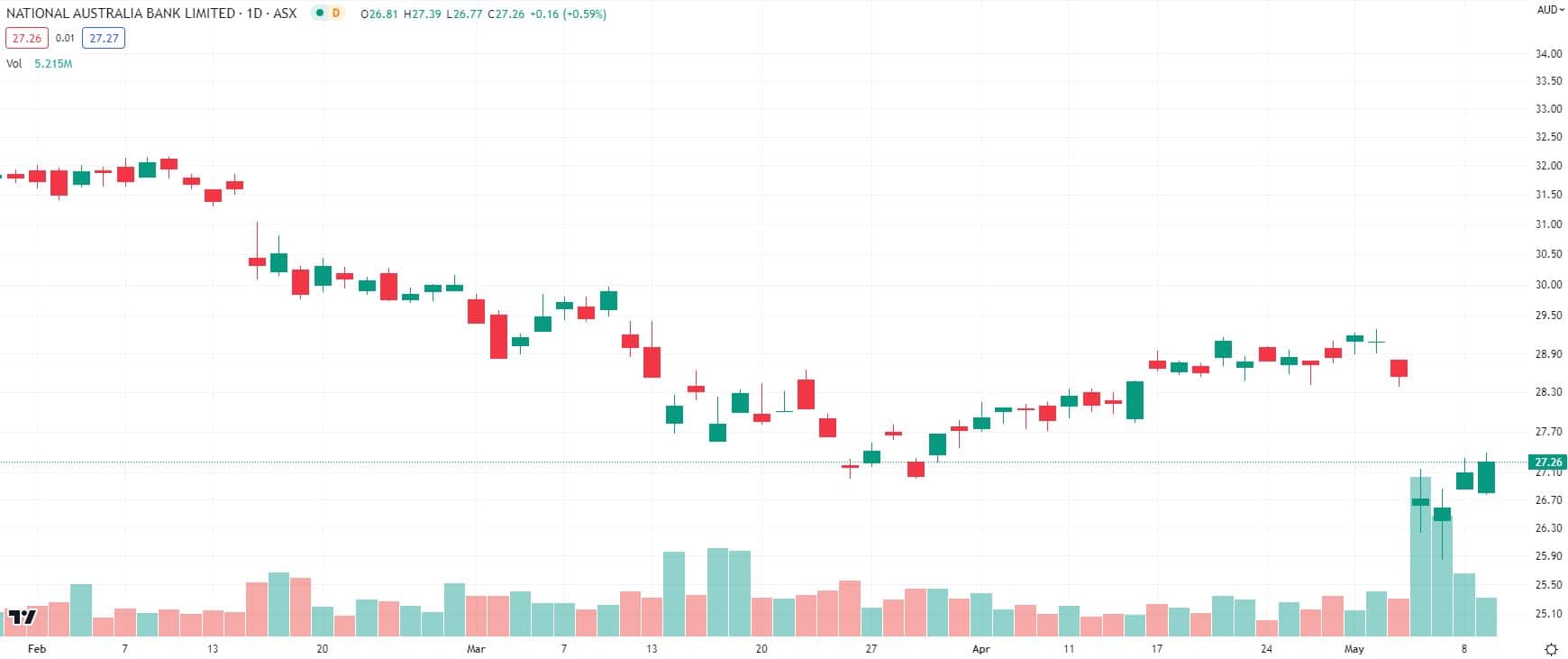The major banks assert times are tough, but they’re still making bumper profits. Are they right to cry poor?
![]() Nick Sundich, May 10, 2023
Nick Sundich, May 10, 2023
The major banks (The Big 4 – ANZ, CBA, Westpac and NAB – to be specific) all released 1HY23 results or 3Q23 trading updates in the past week. All of them recorded multi-billion dollar profits. But they all warned of tough times ahead. Are these profits at risk of turning into the red? Or is it a case of rich companies unfairly crying poor?
Do you need solid trading & investment ideas on the ASX? Stocks Down Under Concierge can help!
Concierge is a service that gives you timely BUY and SELL alerts on ASX-listed stocks – with price targets, buy ranges, stop loss levels and Sell alerts too. We only send out alerts on very high conviction stocks following substantial due diligence and our stop loss recommendations limit downside risks to individual stocks and maximise total returns.
Concierge is outperforming the market by a significant margin!
GET A 3-MONTH FREE TRIAL TO CONCIERGE TODAY
The major banks report results
It has been reporting time for the major banks in the last week with NAB, Westpac and ANZ reporting 1HY23 results, while CBA issued a 3Q23 trading update. It all kicked off last Thursday (May 4) with NAB reporting pre-tax earnings of $4.1bn (up 17%, but below consensus estimates) and declaring a 83c per share interim dividend (up 10%). Its Net Interest Margin (NIM) was up by 0.14 percentage points to 1.77% and cash return on equity was 13.7%.
Next came ANZ, which reported 24 hours later. It made a 1HY23 cash profit of $3.82bn, up 23% compared to 12 months ago and in line with consensus estimates. Its interim dividend was 81c per share (up 11% from a year ago) and its NIM was 1.75% on a statutory basis.
Fast forward to Monday May 8 and Westpac unveiled a $4bn 1HY23 profit (up 22%) along with a 1.96% NIM. It declared an interim dividend of 70c.
And the very next day, CBA issued unaudited results for 3Q23. The biggest of the major banks unveiled a $2.6bn profit to its investors. It did not update its NIM from its 1HY23 results (issued in late February), although its NIM at that time was 2.1%. The interim dividend was $2.10 per share.
The major banks have it very good, so why are they behaving as if it things are bad?
Do investors fear that there will be wide-spread mortgage default and SME bankruptcies? Whether or not this is the case, this isn’t happening to the big 4 banks just yet and it is unlikely to, in our view. But it is clearly not going to be a period of rapid profit growth as investors may have anticipated 6 months ago. We would observe 3 points.
First, as interest rates continue to refinance, borrowers are seeking to refinance en-masse. Banks are having to provide cashback offers and/or lower rates than the standard rate in order to attract new customers and retain existing ones. Hence, it is hardly the case that NIMs have more than doubled from pandemic lows even though their standard variable rates have. In fact, CBA and Westpac have warned that NIMs peaked last October and are now in decline. While ANZ did not give specific NIM guidance, CEO Shayne Elliott warned that the next six months would be more difficult than the last.
Secondly, not all the banks are capturing the growth in mortgages equally, nor will they continue to. To illustrate, CBA grew 1.2x system growth whilst NAB’s was 0.6x. But CBA is clearly taking a step back, telling shareholders it would be ditching cashback offers to new borrowers at a time other banks will continue to. Westpac made the general comment that it would prefer to make such offers to keep existing borrowers and not so much to acquire new ones. Given Westpac has retained 84% of borrowers rolling off fixed-term rates, you could argue it has little need to search for new business.
Third, there is no evidence that interest rates have peaked in Australia. When the RBA briefly paused hiking interest rates before hiking again last week, you’d be forgiven for thinking it. There is still a large volume of low-rate loans to roll over throughout the rest of CY23 and CY24. So in that sense, it is still early. Even if interest rates start to decrease in CY24, they won’t return to pandemic levels. Furthermore, if interest rates do decrease, it might be that a negative macroeconomic situation will have emerged by then.
So which is the best major bank to be in? And which is the worst?
We think CBA is the best poised major bank given its bumper profits and its clear retreat from the competition in the mortgage market. It is difficult to say which bank is the worst off, although investors clearly think it is NAB considering its 15% decline in 3 months (see chart below).

NAB (ASX:NAB) share price chart, log scale (Source: TradingView)
NAB’s results were far from the worst, but it had been on a golden run since the dark days of the Banking and Financial Services Royal Commission. All this said, we think there are better places to park your money in instead of the major banks right now.
Stocks Down Under Concierge is here to help you pick winning stocks!
The team at Stocks Down Under have been in the markets since the mid-90s and we have gone through many ups and downs. We have written about every sector!
Our Concierge BUY and SELL service picks the best stocks on ASX. We won’t just tell you what to buy – we give you a buy range, price target, a stop loss level in order to maximise total returns and (of course) we tell you when to sell. And we will only recommend very high conviction stocks where substantial due diligence has been conducted.
Our performance is well ahead of the ASX200 and All Ords.
You can try out Concierge for 3 months … for FREE.
GET A 3-MONTH FREE TRIAL TO CONCIERGE TODAY
There’s no credit card needed – the trial expires automatically.

Blog Categories
Get Our Top 5 ASX Stocks for FY25
Recent Posts
The $3m super tax is coming! If you’re invested in equities, here is how it might impact you
It seems during the next 3 years, the $3m super tax will be officially a thing. Itwas blocked by the…
Northern Star Resources (ASX:NST): The $28bn gold miner that stands above them all
Northern Star Resources (ASX:NST) is by far the largest gold company on the ASX, capped at $28bn as of May…
6 ASX stocks you forgot were listed
Here are 6 ASX stocks you forgot were listed Brisbane Broncos (ASX:BBL) No it is not a mistake. This…


